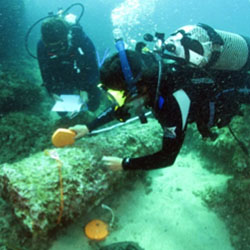August 31, 2013
by Justin Leidwanger, Department of Art, University of Toronto

In mid-August, the Marzamemi Maritime Heritage Project began its first five-week field season with the mapping and excavation of a Late Roman shipwreck off the southeast coast of Sicily. The site, discovered and preliminarily explored a half-century ago, is a popular local dive spot but largely remains a mystery from the standpoint of archaeological research. Comprised primarily of several dozen columns and scores of other decorative architectural elements, the cargo was almost certainly destined to adorn an early 6th-century church in the western Mediterranean. Our efforts this summer aim to map the surface remains and excavate two test trenches in the sandy patches among the reefs and rocks. With the local support of the Soprintendenza del Mare, the Agora Association, and the El Cachalote Diving Center—and thanks to the indispensable financial assistance of the AIA’s Cotsen Grant—we have nearly completed the surface mapping of columns and other major elements in anticipation of initiating excavation and lifting in the coming week.
While the fieldwork is guided by a collaborative team of professional archaeologists from the United States, Italy, and elsewhere, much of the work to date has been undertaken as training for the eleven graduate and undergraduate students from Stanford University and other institutions. Each student normally has the opportunity to dive twice a day, in the morning or afternoon, and learn mapping, photography and artifact study during the other half of the day. Alongside this fieldwork, we are busy with the final preparations for our new conservation facilities and study space in the restored 19th-century winery that will become the local museum. These crucial expenses are often overlooked, but we have been fortunate to cover them through the generosity of the Cotsen Grant. From this base, and with the help of several students of cultural heritage management and museum studies, we are working with the local municipality and archaeological authorities to prepare a plan for how best to engage the public in our efforts, and how the shipwreck might serve to promote better awareness and protection of local underwater cultural heritage among residents and tourists.